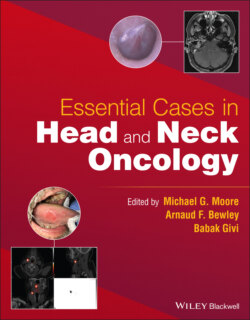Читать книгу Essential Cases in Head and Neck Oncology - Группа авторов - Страница 38
Key Points
ОглавлениеThe oral cavity is the most common location for the development of minor salivary gland tumors due to the high concentration of minor salivary gland tissue in this location.
Adenoid cystic carcinoma is the most common minor salivary gland cancer.
For minor salivary gland cancers of the palate, evaluation includes a detailed history, physical exam, a thorough cranial nerve exam, and a biopsy, often with a fine needle aspiration.
For further assessment of palate salivary cancers, both CT and MRI are typically employed to assess for bone erosion and perineural invasion, respectively.
Due to the close association of the mucosa of the hard palate and the underlying bone, infrastructure maxillectomy is often required.
When considering a patient for an infrastructure maxillectomy, it is essential to consider the expected defect and discuss options for rehabilitation. If the use of a maxillary obturator is considered, a preoperative evaluation by a maxillofacial prosthodontist is crucial to get a surgical obturator created.
To successfully retain an obturator, it is necessary to have adequate dentition to stabilize the prosthesis. Retention of the ipsilateral canine tooth typically allows for excellent obturator stability.
In patients where a maxillary obturator is not appropriate or desired, more definitive reconstruction with a regional or free flap is needed.
